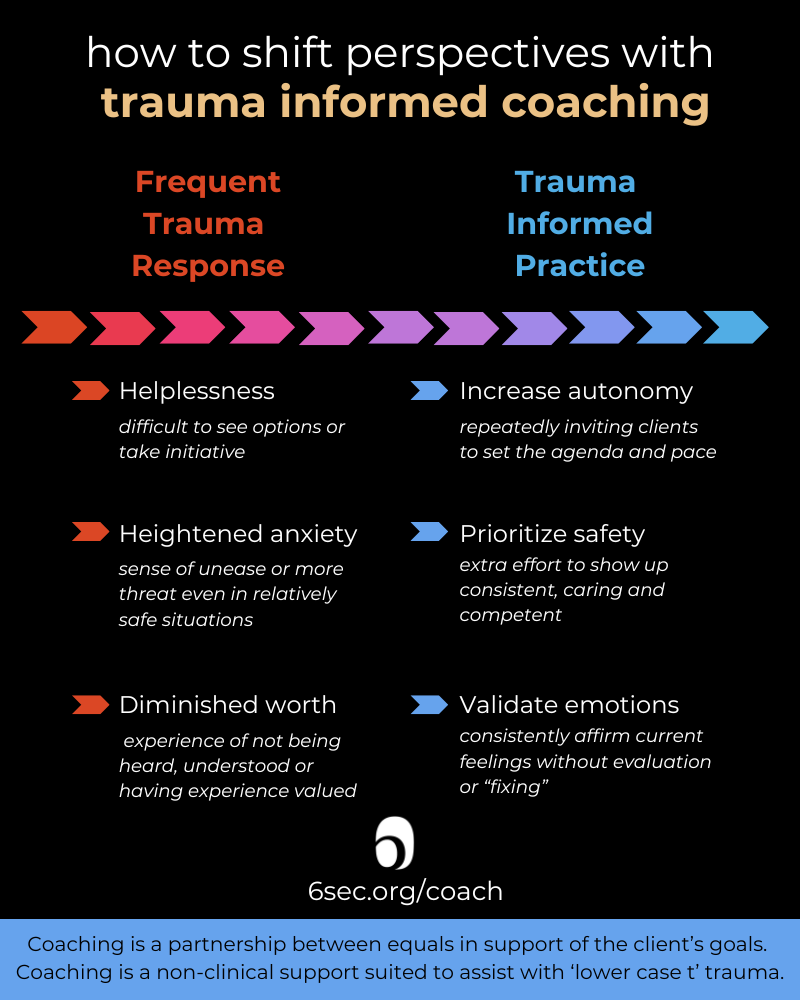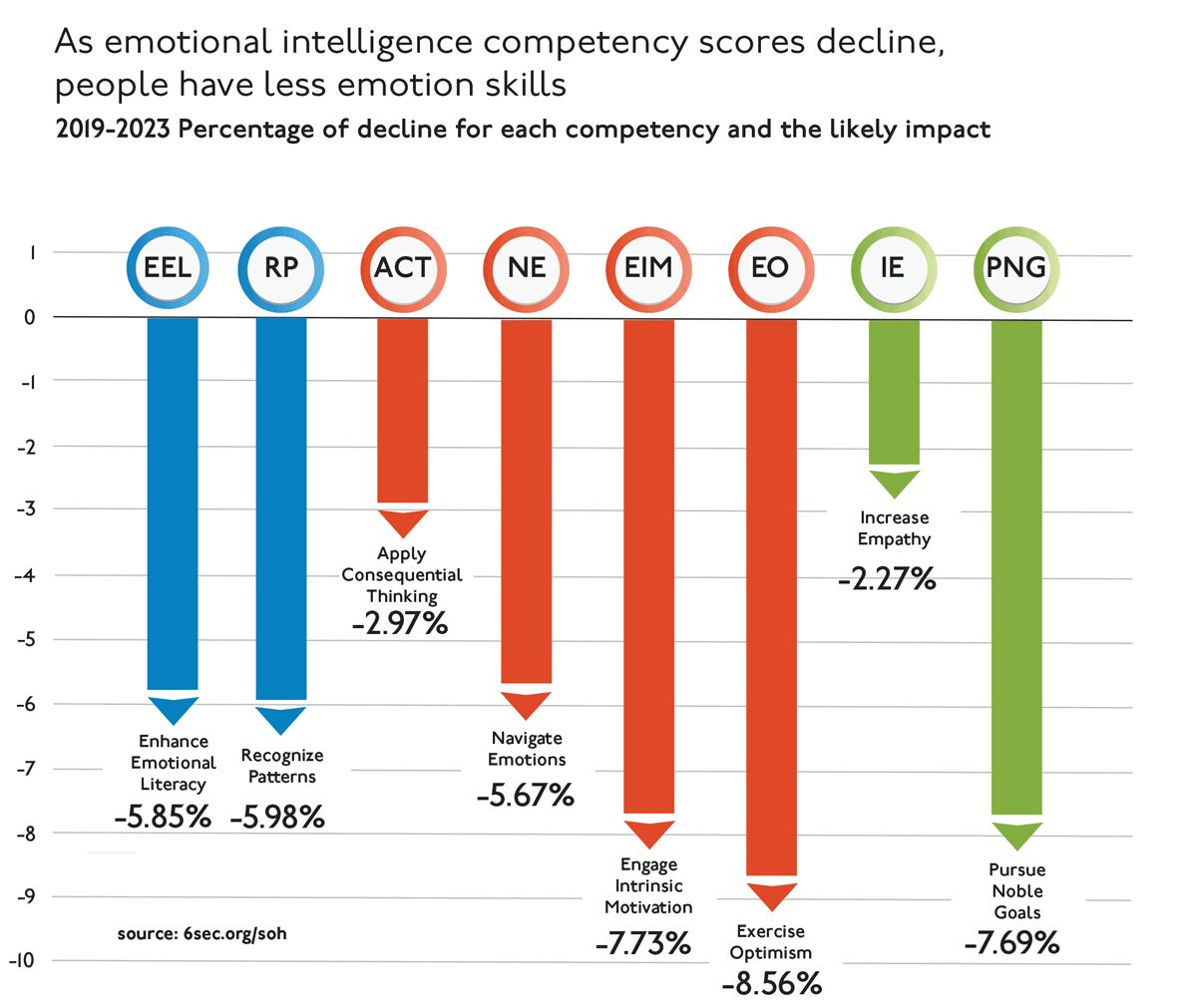World Health Organization Director-General Tedros Adhanom Ghebreyesus said in March 2021, “When there is mass trauma, it affects communities for many years to come.” While coaching isn’t a “treatment” for trauma, in the Emotional Recession we’re facing now, chances are, your clients, colleagues, and you are carrying more trauma than 4 years ago. What do we do as coaches?
Coaching Through the Emotional Recession: Three Practical Tips for Trauma-Informed Coaching 🌱
The pandemic era excised extraordinary demands on our workplaces, communities and classrooms – and the bill is coming due. When I presented with Dr. Tedros to the WHO’s employees about emotional intelligence and wellbeing, one clear key takeaway was to counteract the heightened distress, we need to strengthen emotional skills. According to the new State of the Heart research, it’s even more urgent today.
“Capital T Trauma” vs “Lower-case t trauma”
Psychological trauma is a complex, dangerous brain injury that requires treatment from qualified clinicians. This “Capital T Trauma” can lead to Post Traumatic Stress Disorder and other illnesses. Dr. Bessel van der Kolk is a prominent scholar, best known for his book “The Body Keeps the Score,” which explores how trauma reshapes both body and brain, potentially leading to significant challenges.
Meanwhile, literally billions of people experience small traumas such as prolonged stress, disruptions to support systems, or relationship issues. These “lower-case t trauma” can add up over time to deplete or drain our reserves and make us more vulnerable or less resilient. At a large scale, these create an Emotional Recession. Many scholars and psychologists (such as Dr. Bruce Perry, Dr. Gabor Mate, and Dr. Judith Lewis Herman) offer strategies we can adapt to take a “trauma informed approach” to our non-clinical work.

This article is from the 🌱 Emotional Intelligence Coach Newsletter
Click here & choose the newsletters that will help you practice and grow emotional intelligence
Confronting the Emotional Recession
The 2024 State of the Heart Report identifies that after four straight years of declining emotional intelligence scores, and reductions on every EQ competency, we’ve entered a global Emotional Recession. As I explained on LinkedIn, it’s easy to understand “Emotional Recession” by looking at the way economists define a financial recession: A prolonged contraction of economic output. Typical signs are reduced GDP, increased unemployment, and rising costs.
In parallel, the Emotional Recession means we’re facing a prolonged reduction in input to the economy – ie, people are less able to be productive. Signals include reduced emotional capacity, increased distress, and rising burnout levels.
Reduced capacity: All emotional intelligence competencies have declined in the last 4 years, many over 10%.
Increased distress: Globally, wellbeing dropped by over 5% in the last 4 years.
Rising burnout: 65% of workplace sectors face higher burnout vs 4 years ago.
What Emotional Recession Means As a Coach
Statistically, the average client you talk to today will be experiencing the effects of emotional recession – and so will you. Consider the graph to the right and excerpt below from the State of the Heart report:
“Three of the largest declines all have to do with creating the energy to move forward. In a time of deep challenge,
Exercise Optimism is the skill they need to see new options, but right now they feel helpless.
Engage Intrinsic Motivation provides an inner drive to take action, but now they feel stuck.
Pursue Noble Goals gives someone a sense of purpose, a vision of a better future – but right now they feel cut off from that deeper meaning.” -State of the Heart 2024 (6sec.org/soh)
Now think about coaching where you’re frequently working with clients to explore new options (which requires Exercise Optimism), to step forward (which requires Engage Intrinsic Motivation), and to connect their choices with a larger sense of purpose (which requires Pursue Noble Goals). So our core work as coaches is going to be harder in 2024 vs 2019.
What is “Trauma Informed” Coaching?
Again, in this context, we’re talking about professional coaching as a non-clinical intervention, part of community-based support within a continuum of care. From that perspective, we can learn from clinicians and use that to inform how we can better support people as they work with clinicians on “Capital T Trauma,” or for everyone grappling in their daily lives with “lower-case t trauma.”
There are many ways people respond to trauma. Sometimes they become less emotional, but others become more volatile. Sometimes they become more withdrawn and risk-adverse, but others become more risk-prone. This complexity is another reason that as coaches, we are not in a position to diagnose. We can, however, prepare ourselves to be better coaches by learning more about the psychology of trauma. More on this at the end of the newsletter.
Three Trauma Informed Approaches for Better Coaching in the Emotional Recession
With the background on trauma in mind, and recognizing the depth of the current Emotional Recession… how can you be more effective as a coach using trauma-informed strategies? Three approaches:

Increase Autonomy
People experiencing trauma often feel helpless, so take extra care to ensure you’re actively inviting the client to set the direction and speed of your session. To do so, consider your use of power, including the power of your role (the coach) and identities (eg race, age, gender, culture, education, language, etc). These factors can add un-intended force – you might not see yourself as asserting this cultural power, but someone else might feel it.
My “first rule of emotional intelligence” is: When people feel pushed, they resist.
Note that it doesn’t mean you ARE pushing (though you might be), if people FEEL pushed, as a coach, you have a problem to solve. Notice where you’re using overly assertive or coercive language or tone: You have to…. It’s important that you… It’s time for you to…. Tell me about…
Non-coercive language is often more tentative, more curious, more open-ended:
You have to → What’s calling you to… ?
It’s important that you → What’s important for you?
It’s time for you to → When’s the time for you to… ?
Tell me about → Would you like to tell me about…?

Prioritize Safety
People who have experienced trauma often feel threatened in unfamiliar or unpredictable situations, so creating a coaching environment that is secure and consistent can help reduce their anxiety and build trust. This includes physical safety and emotional predictability through clear communication and confidentiality.
To do so, it may help to remember the meaning of trust: it’s the emotional signal of safety and connection. How? In Six Seconds’ Vital Signs Model, we identify three key “pulse point” for trust:
Transparency: share more truth – open up the coaching conversation as a shared space for vulnerable honesty
Coherence: walk the talk – show people you’re trustworthy, don’t just tell them. Ensure you do what you say you’ll do and make that visible. Reiterate it. Put your values into action clearly and consistently, and when you make a mistake, own it.
Care: foster genuine connections – ensure people feel you’ve got their backs. Tell them, but even better, show them through your presence and the quality of your listening.

Validate Experiences and Emotions
People facing trauma may feel their experiences are misunderstood or not believed, so you can acknowledge and validate their feelings and narratives without evaluation so they feel something different with you. Treat their emotions as real and valuable, even (especially) when you don’t understand why they’re feeling the way.
Acknowledge: That sounds hard.
Ask: Would you like to tell me more about it?
Then, it’s a good time my favorite coaching question: What else are you feeling?
In contrast, some people will minimize or dismiss their experiences, as doing so can exacerbate feelings of isolation or misunderstanding. That’s invalidation, a message that their current feelings are not right or acceptable. In contrast, validation is about seeing and showing that you value what’s happening. You don’t need them to change or hide or fade their feelings and “seem ok.” Coaching is a space where all emotions are welcome.
Research Recommendations for Five Key Approaches for Trauma Informed Coaching
After exploring research on trauma informed practice, I interacted with ChatGPT to develop the following summaries of you can explore future study; I added links; below, I’ve highlighted three of these strategies:
Trauma informed approach: Prioritize Safety
According to Bessel van der Kolk, author of “The Body Keeps the Score,” safety is the cornerstone of trauma treatment. He highlights how trauma disrupts the brain’s perception of safety, making the establishment of a secure environment critical for effective therapy and coaching.
Trauma informed approach: Increase Autonomy
Judith Herman, a psychiatrist and researcher, emphasizes the importance of empowerment in her seminal work, “Trauma and Recovery.” She suggests that healing from trauma requires a process where the survivor is the primary director of their recovery, affirming the need for autonomy and control over one’s therapeutic journey.
Trauma informed approach: Validate Experiences and Emotions
Dr. Brené Brown, a research professor who has spent years studying courage, vulnerability, shame, and empathy, underlines the importance of empathy and validation in her book “The Gifts of Imperfection.” She discusses how empathy, which involves validating others’ feelings, is crucial in creating a sense of connection and supporting healing.
Trauma informed approach: Build on Strengths
A strengths-based approach, supported by researchers like Barbara Fredrickson, focuses on clients’ inherent strengths and resilience. Fredrickson encourages a recognition of past successes and using strengths to foster positive emotions and personal growth.
Trauma informed approach: Practice Healthy Coping Skills
Dr. Jon Kabat-Zinn, founder of the Mindfulness-Based Stress Reduction program, has extensively explored how mindfulness and coping skills can significantly reduce stress and emotional reactivity. His research provides a strong foundation for using mindfulness and other coping strategies in trauma-informed practices.
As usual, my recommendation is you try these tips on yourself first. Then adapt and experiment – and please share with the rest of us what you learn along the way!
And, if you have questions you’d like me to explore in a future 🌱 EQ Coaching newsletter and/or video, please post in the comments, or feel free to reach out to me via our contact form.
… and don’t forget to Click here to subscribe to the EQ Coach Newsletter.
Whether you’re a professional coach, or contemplating earning certification as a professional emotional intelligence coach*, or you’re someone who uses coaching techniques to support others: of course these questions apply to us first.
* Did you know? In addition to top-level accreditation from the International Coaching Federation, the EQ Coach Certification is one of a handful of coaching certifications in North America that also provides master’s level credit? You’ll earn almost ⅓ of your MBA or MA in this program.
For more on EQ and Coaching 🌱, I recommend:
- Coaching Through the Emotional Recession: Three Practical Tips for Trauma-Informed Coaching - May 1, 2024
- Knowing Isn’t Coaching: Three Emotional Intelligence Tools for Professional Coaches - April 3, 2024
- Coaching Down the Escalator: 3 Emotional Intelligence Tips forCoaches to Reduce Volatility & De-escalate Conflict in a Polarized World - March 6, 2024

